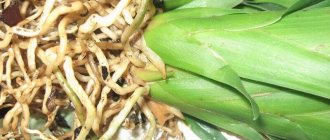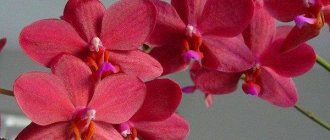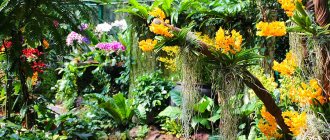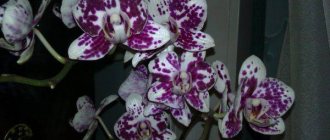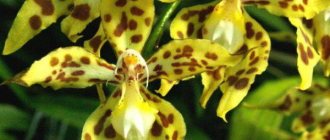Plants » Flowers
0
1798
Article rating
Kira Stoletova
Phalaenopsis Lewis Sakura is considered one of the most popular flowers. He personifies femininity. The plant does not require special care and adapts to negative environmental factors. The flower's hardiness allows it to be grown in any conditions.
Growing Phalaenopsis Lewis Sakura
Replanting and fertilizing phalaenopsis
A healthy-looking plant is replanted every 2-3 years.
It is recommended to engage in this process after flowering has completed, preferably in the summer or late autumn. The main reasons for replanting are: the small volume of the pot or its damage; unpleasant odor from the substrate, its salinity; the appearance of pests.
The ideal type of pot is considered to be transparent. It is here that the process of photosynthesis of roots occurs best.
Before planting in the substrate, you need to carefully examine the roots, cut off dry and rotten particles, and make sure there are no pests.
Land for replanting can be purchased at any flower shop or prepared yourself. Tree bark, pieces of coal, sphagnum moss, and pieces of shells are suitable for these purposes.
The following soil composition for phalaenopsis also has a positive effect on the root system: pebbles (needed for drainage), charcoal, a small amount of dry pine bark.
To give the plant a blooming appearance, it is recommended to use phosphorus extracts or other “orchid” fertilizer purchased at a flower shop.
You can also spray the leaves with a slightly diluted solution, since beneficial substances also come through them.
Dilute the product strictly according to the instructions so as not to cause burns to the roots and leaves.
Features of tree care
Anredera: photo, description, use, planting and care at home and in the open ground
Sakura varieties have many differences in cultivation techniques. To grow bonsai sakura, the roots are shortened every season, and horizontal cuts are made on the bark, right on the trunk. For a garden tree, these methods are irrelevant - you form a seedling in a room, and then transplant it into open ground.
The rules for caring for a specific variety differ. A common feature is that trees are capricious and require daily attention. The tree needs soil enriched with humus, potassium, and nitrogen. During the season, sakura is watered with half a glass per day, in winter - less often
The plant needs good lighting and no drafts.
Sakura bonsai
The secret of the beauty of sakura is not only in large and abundant flowers, but also in the aristocratically built crown. It can be formed starting from 2-3 years of age of the plant. In the natural and miniature versions, the branches are arranged according to the same pattern. The crown can mean a straight trunk, a bend in the spirit of centuries-old Japanese cherry blossoms, or widely spread branches.
Advice. To create a wide crown, prune the main shoot when you think it is tall enough. You can also trim the side shoots to correct their direction.
The secret of the name
How many years does a phalaenopsis orchid live?
how to determine the age of this flower The genus Phalaenopsis belongs to the epiphytic plants of the Orchidaceae family. The plant is native to the plains and forests of Southeast Asia, the Philippines and northeastern Australia. The characteristic structure of plants belonging to this genus includes:
- Long vertical stem.
- Several large fleshy leaves arranged in two rows.
- Large velvety flowers, similar to exotic butterflies.
Thanks to these flowers, phalaenopsis got its name, since in translation from Greek phalania means “night butterfly” and opsis means “resemblance.”
In nature and special nurseries, there are about 70 species and a huge number of hybrid varieties of phalaenopsis orchids.
Features of transplantation
Spring Festival: sakura in the interior of a city apartment
It is better to replant the purchased plant immediately, replacing the soil with fresh one. You also need to carefully check the roots. In purchased containers they often entwine the entire substrate.
In this situation, they need to be carefully untangled. Remove rotten and wet ones. If the roots are completely healthy, the Cymbidium stardust can simply be transferred to a slightly larger pot. No clear container required. The best material is porous ceramics.
The main requirement for the substrate is lightness and ability to pass air. One type of mixture: pieces of coal, pebbles, pumice and pine bark with moss. The nutritional components will be peat fibers, dry leaves and some horn shavings.
Transplantation step by step:
Pour water-soaked substrate into the bottom of a container with drainage holes.
You need to take enough of it so that the orchid in the pot grows at the same level. Carefully remove the cymbidium from the old container and examine the roots as described above. Spread them on fresh soil without twisting them. Fill the empty space and compact the soil. This procedure is carried out every three years after flowering has completed.
The condition of the bulbs will serve as a signal for transplantation. If in the center they are brown and dried out, and at the edges there is a green mass and roots protruding from the pot, it’s time to change the container and substrate
This procedure is carried out every three years after flowering has completed. The condition of the bulbs will serve as a signal for transplantation. If in the center they are brown and dried out, and at the edges there is a green mass and roots protruding from the pot, it’s time to change the container and substrate.
For a week after transplanting, watering is reduced.
Often the owners of these exotic plants are interested: there are a lot of leafless bulbs on the cymbidium, what should I do? The leaves of the flower remain green for about three years. After which they gradually die off.
Only pseudobulbs remain, which remain alive for several more years. Gradually they will shrink and die.
Note! A living pseudobulb is capable of sprouting. Therefore, you should not throw them away; it is better to plant them and encourage the appearance of young plants.
Planting seedlings and growing conditions
The main problem when growing sakura in central Russia is low winter hardiness.
This problem can be solved with vaccination. A winter-hardy variety of local cherry is selected as a rootstock.
Vaccination is carried out using the budding method in the first half of May.
At the same time, it is very important to be in time before the onset of the summer heat, and also to avoid recurrent frosts.
The vaccination technique is as follows:
- A T-shaped incision is made on the rootstock bark at the grafting site with a sharp knife.
- The bark at the incision site is carefully lifted with a knife and bent slightly.
- A pre-prepared sakura eye with a viable bud is inserted into the incision site.
- The vaccination site is tightly wrapped with a special vaccination tape. If you don't have it, you can use regular electrical tape.
- After 15 days, the bandage must be loosened.
- Sakura grown by grafting usually blooms in the 3rd year of cultivation.
When choosing a place to place sakura in the garden, preference should be given to loam with a neutral soil reaction. Good drainage is also a must.
When planting a seedling in a hole, it is advisable to add half a bucket of well-rotted manure. If there is a slope, sakura should be placed on the southwest side. In the south, the tree will suffer from insufficient humidity in the summer and from temperature changes and sunburn in the winter.
The process of planting sakura is as follows:
- A hole is laid 50 cm wide and about 40 cm deep.
- In the center of the hole, a small mound is made from a mixture of excavated soil and humus.
- A seedling is placed on the top of the mound.
- The root system is carefully covered with earth.
- The soil around the trunk of the seedling becomes compacted.
- A peg is driven in next to the seedling for tying.
- The seedling is tied to a peg using twine.
- The planting site is thoroughly watered.
Follow these rules carefully and you will succeed.
Caring for a sakura tree involves timely watering and loosening the soil in the circle around the trunk.
This is especially true for seedlings and young trees during the period of bud formation. If the tree at this moment lacks moisture, then you can’t expect abundant flowering from it.
Also, when growing this crop, it is very important to apply nitrogen and potassium fertilizers on time. The lack of these elements negatively affects the abundance and duration of flowering
When grown on poor soils, humus must be added every two years. All fertilizing is best done after abundant watering of the tree trunk circle.
The lack of these elements negatively affects the abundance and duration of flowering. When grown on poor soils, humus must be added every two years. All fertilizing is best done after abundant watering of the tree trunk circle.
Beautiful spring sakura blossoms
Every spring, before sap flow begins, it is necessary to carry out sanitary and formative pruning of the tree. During it, all diseased, damaged and dry branches are removed. In order for the tree to have a neat and well-groomed appearance, during the pruning process, all shoots that thicken and grow inside the crown should be removed.
Attention! After pruning is completed, all sections must be treated with garden varnish. This will prevent such an undesirable phenomenon as gum deposition.
Very often, adult sakura plants suffer from frost damage. They cannot be ignored. To help the plant cope with damage, all dead tissue is cut out to a healthy place.
After this, the cleaned areas are treated with a 1% solution of copper sulfate. After such treatment, the damaged areas are additionally covered with garden pitch or a mixture of clay and mullein.
When growing sakura in central Russia, the trees must be additionally covered for the winter.
To do this, in the fall, after the onset of stable frosts, the trunk and the grafting site are wrapped in several layers of non-woven covering material. For example, you can use Spunbond or Lutrasil.
Phalaenopsis Lewis Sakura: photo
Phalaenopsis Lewis Sakura is considered one of the most popular flowers. He personifies femininity. The plant does not require special care and adapts to negative environmental factors. The flower's hardiness allows it to be grown in any conditions.
Growing Phalaenopsis Lewis Sakura
Features of the variety
The variety was bred in Central Asia. It is called phalaenopsis sakura because it resembles the Japanese cherry tree. The main stem is straight. Its height is about 60 cm. The peduncle reaches a height of 30-45 cm.
The leaves of Phalaenopsis Lewis Sakura are large in size and reach 20 cm in length. Their color is rich green and does not change throughout the life of the flower. According to the description, the leaves form a leaf rosette during development. Shoots form from it and the root system develops. The roots are dense and thick. The lifespan of the plant is approximately 20 years.
The plant blooms 3 times during the year. Often this process lasts for 50-60 days. The orchid remains at rest for 90-100 days. With increasing age, the bush forms more shoots and flowers, and the duration of flowering increases.
Preparing for landing
Phalaenopsis Sakura Lewis cannot be planted in regular soil. Ordinary soil is not able to hold the orchid so that it remains in an upright position and poorly allows oxygen to pass through it. It is better to plant the crop in pine bark. Before planting, the soil must be disinfected. For this, use a manganese solution (4 g per 10 liters of water).
Phalaenopsis Sakura Lewis is a light-loving orchid. Even the root system needs a lot of light, so transparent containers are used for planting. Ordinary glass jars or transparent plastic food containers are often used as pots.
Planting stages
Planting a flower is not at all difficult
The plant should be in an upright position. To do this, planting is carried out according to certain rules.
- 200-300 g of substrate is poured into the prepared container;
- a seedling is placed there in a vertical position;
- The roots and the seedling itself are gradually sprinkled with soil so that the substrate forms the top layer.
After planting, the crop is watered with a small amount of water (1-1.5 liters per bush). The flower is placed in a dark place and after 3-4 weeks is transferred to well-lit areas.
Transfer rules
Transplantation is carried out 2 times a year: in spring or autumn.
It is prohibited to replant a flowering plant: there is a possibility of damaging the root system. Orchids are propagated using sprouts. Suitable for the procedure are shoots with a formed root system and no damage to the surface.
Home care
To grow a beautiful and healthy plant, it is important to properly care for it. The culture should receive a large amount of oxygen, but it should not be left in a draft. Daytime temperature should be 25°C, and night temperature should be 15-18°C
The daytime temperature should be 25°C, and the night temperature should be 15-18°C.
The Lewis Sakura orchid is watered in a non-standard way: an adult plant is dipped in warm water (about 20-23°C). Irrigation work is carried out no more than 2 times a month, kept in water for 25-40 minutes. After this, the pot with the flower is removed from the water and left for 40-60 minutes for the liquid to completely drain from the pot.
Feeding is carried out every 14-18 days. For this purpose, mineral components are used. An excellent option is to water with a solution of potassium nitrate (50 g per 10 l of water) or superphosphate (30 g per 10 l of water).
Diseases and pests
Main diseases: root rot and powdery mildew. It is impossible to get rid of root rot - the entire bush is destroyed. A measure of the fight against powdery mildew is Bordeaux mixture, with which watering is carried out (5 g per 10 liters of water).
The crop is protected from pests, so there is no need to worry about processing and protecting it.
Preventive measures
It is important to carry out timely prevention of diseases in an adult plant: spray the plant with a solution of copper sulfate (2 mg per 10 liters of water). The procedure is carried out at intervals of 7-10 days. Prevention of powdery mildew consists of treatment with phytosporin (20 mg per 10 liters of water)
Prevention of powdery mildew involves treatment with phytosporin (20 mg per 10 liters of water).
P.Liu's Sakura / Phalaenopsis Lewis Sakura / my care I received the phalaenopsis Liu's Sakura “KF” Phalaenopsis as a gift!:) Receiving an order from the orchid forum!
Conclusion
It is easy to grow the Phalaenopsis Sakura Lewis orchid at home. It is necessary to carry out agrotechnical procedures correctly. This variety is unpretentious in care, which only simplifies the process of growing it.
Diseases and treatment
Orchids most often suffer from improper care. But sometimes the sources of diseases are:
- fungi (Anthracnose, Fusarium, Late blight, Black rot);
- viruses (Tobacco mosaic, trichopylia);
- bacteria (bacterial rot, brown spot).
During treatment, it is necessary to get rid of the affected areas. They are cut out to healthy tissue with a sharp, disinfected instrument. Then spray with fungicides: Benomyl; Fundazol; Tiram.
There are no effective drugs for viral diseases. It is necessary to destroy the entire plant so that the pathogen does not infect neighboring crops.
Types of phalaenopsis with photos
Pleasant (amabilis, Amabilis)
Up to twenty delicate white flowers bloom simultaneously on the graceful curved branches of this plant.
Amabilis.
The center is pale yellow with a pattern of pink, red and brown specks.
The edges of the lower petals are narrow and often curved upward, like teeth. The subtle, barely noticeable aroma gives it a special charm.
Schilleriana
The leaves of a plant that grows in suitable conditions have a subtle silvery pattern on the outside, as if marbled.
Schilleriana.
A whole waterfall of petals can bloom simultaneously on one peduncle - 250 flowers is not the limit, but an average number!
Shades of Phalaenopsis Schiller can range from pale pink to sophisticated burgundy.
Stuart (Stuartiana)
A profusely blooming species of Phalaenopsis Stewart, it features an attractive pattern on white flowers.
Stewart's Phalaenopsis has red spots on the base and a specific pattern.
A raceme of several dozen flowers develops on a peduncle up to 60 cm long.
The long, up to 20 cm leaves of the plant also have a pattern of silver-gray rounded spots.
Has a weak aroma.
Sandera (Sanderiana)
It is rare and expensive. The flower brush is located on several branches.
Sanderiana.
The total height of the peduncle is slightly less than a meter, about 80 cm. Large flowers, up to 10 cm in diameter, are white or pink.
The leaves have a dark green complex pattern.
Pink (Rosea)
A petite beauty with an intricate veining pattern on the large upper petals and a contrasting lip in a darker shade of purple.
Rosea. Photo taken from flickr from a certain Carl Baldini.
The name of this species accurately describes the coloring features. The diameter of the flower is only about 3 cm, and the peduncle is no higher than 20 cm. The leaves are a rich dark green color.
Gigantea
Flowers 3-4 cm in diameter are collected in a luxurious inflorescence in the form of a cone, drooping down.
Very large Phalaenopsis gigantea.
The leaves of this giant are often longer than the peduncle - up to fifty cm, and the peduncle usually does not exceed forty.
The flowers are variegated in shades: purple, beige, terracotta. The green mass is also often decorated with a pattern of light gray speckles.
Horse (Equestris)
Small flowers of this species are only 2-3 cm in diameter, but this only adds lightness and grace.
Equestris.
This baby's flower brush is only 20 cm in height, but it looks voluminous and lush.
Many small branches form an airy flower cluster.
At its tip, new buds grow and bloom, thanks to which it blooms all year round with good care.
Staghorn (cornu-cervi)
In comparison with its lush, bright neighbors, this phalaenopsis looks extremely unusual.
The coloring resembles the horns of a young deer.
With its shape, the staghorn phalaenopsis resembles not only the horns of a young deer, but also a starfish.
The shape is noticeably different, the petals look thicker and stronger.
The plant is miniature, but produces several flower stalks with many branches at once.
The inflorescences are varied in color from yellow ocher to reddish brown.
Luddeman
The petals look like they were painted by an artist. This species is extremely varied in colors.
Phalaenopsis Luddeman.
There are yellow flowers with red stripes, white with purple. A plant in full bloom can bloom regardless of the time of year.
Although there are very few flowers on the peduncle, no more than 7, they are quite large and smell pleasant. Average diameter 6 cm.
Ambonian (amboinensis)
This species of the orchid family blooms all year round, opening buds one after another. As a rule, there are several flower stalks at once.
Ambonian phalaenopsis.
Striped petals with bright, attractive colors stand out among the pink and purple palette of popular varieties.
Parisha (Parishii)
Among all the variety of these beautiful plants, there is not a single one that could be called ordinary.
Parishii.
Parisha is one of the more exotic varieties, a tiny potted plant with aerial roots and leaves that looks like a painstaking composition created by a florist.
Hybrids based on it are used to create mini-phalaenopsis.
Hieroglyphic (hieroglyphica)
The complex painting on the individual petals of this large plant is not repeated even on one peduncle.
Hieroglyphic.
Leaves up to 30 cm, many flowers on several peduncles look like a living bouquet.
Leaves and flower stalks tend to droop, so a stand is needed. A plant full of detail and personality.
Description of the variety
The full name of the flower is Dorithenopsis Lewis (Louis) Sakura. The hybrid appeared in Taiwan in 2012 through intergeneric crossing of orchids - “Phalaenopsis pleasant” with “Doritis most beautiful”. His parents gave him the best of everything - endurance and sophistication.
Since 2013, Orchid Sakura includes:
- Princess - with an unusual lip and mother-of-pearl petals;
- Mickey - with small, tightly seated leaves, a short (up to 20 cm) peduncle and flowers 7 cm in diameter, densely covering the stem.
The main feature of the family is its similarity to the blossoms of Japanese cherry trees. But the appearance of Sakura Lewis caused a real stir: for the first time the world saw a lacy creature with the finest shades of white, pink, and lilac.
Lewis Sakura
Distinctive features, external characteristics
Phalaenopsis Lewis Sakura is considered one of the most feminine flowers. This is an unpretentious and hardy plant.
The stem of the crop is erect or slightly inclined. The growth of the flower can reach 60 cm, the peduncle – 40 cm.
Lush evergreen leaves 10–30 cm long are collected in a rosette from which shoots and thick aerial roots grow. The lifespan of a flower is 10 – 15 years.
Lewis Sakura variety.
Colors
Basically, the orchid has soft pink flowers along the edges, framed by a lilac border. The core of the inflorescences is yellow or orange.
There are flowers that are pale matte with a red throat, yellow with a purple tint, white with red specks in the middle, or completely purple.
Features and duration of flowering, dormant period
The flower blooms 2 times a year, for 2 months. The rest period is 3 months.
With age, the plant increases the number of shoots, peduncles and flowering period.
Find out in the video how to properly care for Lewis Sakura:
Home care rules
These are generally known for Phalaenopsis .
Conditions of detention
- Choose a location for the plant . Well lit. Even in winter: For full growth and flowering, it needs to be in the light for 12-15 hours;
- If it’s not enough, highlight it;
- Avoid direct sunlight;
Watering and fertilizing
It is imperative to follow the watering rules.
You need to choose a middle ground:
- Excesses can cause root rot;
- Lack leads to withering;
- Carry them out at least 2 times a week in the morning (the condition of the roots and soil will tell you when to do this);
- Use settled, distilled, boiled, melt water . Warm;
- Use immersion of the pot in another container. For 20-30 minutes;
Attention! Study the instructions for using fertilizers. Experts and amateurs unanimously talk about a decrease in concentration. It doesn’t seem surprising to you when experts and amateurs recommend using various fertilizers at a rate of 50%, as indicated in the instructions for use. Maybe let the authors of the instructions read it too.
- You must make sure that there is no stagnation of moisture in the roots ;
- Check the leaf axils;
- Gently wipe the leaves after watering .
Disease Prevention
It wouldn’t hurt to know about possible diseases and potential pests:
- Create conditions for orchids in their natural climate : Temperature;
- Humidity;
- Ventilation.
Sakura
The most favorite flowers of the Japanese
Sakura is a tree of the Plum subfamily of the Rosaceae family. The color of the flowers varies from snow-white to crimson and scarlet. Japanese law does not define the “state flower,” but sakura has become so firmly established in Japanese culture that it can be considered a symbol of Japan along with the chrysanthemum.
There are more than 600 varieties of cherry blossoms in Japan, including native and hybrid varieties. Somei-yoshino is the most common
with five-petaled pale pink flowers, developed in the mid-Edo period (1603-1868) and spread throughout the country from the Meiji period (1869-1912).
Sakura variety Somei-yoshino
The Japanese cherry tree occupies such an important place in Japanese culture that the word “flowers” in literature is often used as a synonym for the word “sakura”, dating back to the Heian period (794-1192). Spring picnics with relatives, colleagues, and acquaintances under the cherry blossoms are an integral attribute of spring in Japan.
In all regions of Japan there are places famous for the beauty of cherry blossoms, and even some individual cherry trees are famous throughout the country. Such, for example, is the very old “Sakura of the Age of the Gods” (Jindaizakura
) in Yamanashi Prefecture, which is about 2000 years old, or "Sakura Falls in Miharu" ( Miharu-takizakura
), which is more than 1000 years old, in Fukushima Prefecture.
Cherry blossoms are also closely connected with new meetings and partings, with turning points in human life. The financial and academic year in Japan begins on April 1, and this date falls during the time when cherry blossoms bloom in Kanto and more western regions (usually from the last ten days of March to mid-April). This is when school graduation events take place, this is the period of admission to school, to work, and those who successfully passed the entrance exams are said to have “sakura blossoms.”
Ueno Park in Tokyo while admiring the sakura
Sakura in Japanese cuisine
Sakura is not only admired. Wood, flowers, leaves, and sakura fruits are used on the farm. The fruits of some varieties are eaten. Soft flowers of oshimazakura
and Yaezakura
salted and then prepared from them into sweets or other dishes.
Pickled sakura flowers, if thrown into hot water, take on their previous shape, as if blooming again, and therefore have a benevolent meaning and a drink from them, sakurayu
, are a favorite treat during dates arranged for the purpose of marriage ( o-miai
), or at weddings. In addition, these flowers are used to decorate bread or cookies, and are also boiled with rice to add flavor.
Cherry blossom drink - sakurayu (left) Pink sakuramochi rice cake made from glutinous rice and botamochi made from a mixture of glutinous and regular rice (right)
Sakura in Japanese culture
Sakura was first mentioned in the chronicle-mythological collection “Annals of Japan” ( Nihon shoki
), completed in 720. It tells how a flower fell into a bowl of sake held by the 5th century Emperor Rityu. In later literature, there are many works in which sakura appears. They are not only about the beauty of flowers and hanami
, “admiring flowers” under flowering trees. The exquisite features of beautiful women are likened to sakura flowers, they express respect to sakura, which blooms for so short a time and then crumbles overnight, they see in it a courageous acceptance of one’s fate and cite it as an example of impermanence, the frailty of existence. Thus, sakura became a symbol of the fleeting beauty of the transient, having a certain influence on the formation of ideas about life and death.
The Japanese love for sakura survived the post-war reforms and now manifests itself in music. One of the most famous songs, a kind of “calling card” of Japan, is called “Sakura, Sakura”, and in general the number of songs with this word in the title has exceeded a hundred; songs whose lyrics mention sakura are impossible to count.
Features of tree care
Sakura varieties have many differences in cultivation techniques. To grow bonsai sakura, the roots are shortened every season, and horizontal cuts are made on the bark, right on the trunk. For a garden tree, these methods are irrelevant - you form a seedling in a room, and then transplant it into open ground.
The rules for caring for a specific variety differ. A common feature is that trees are capricious and require daily attention. The tree needs soil enriched with humus, potassium, and nitrogen. During the season, sakura is watered with half a glass per day, in winter - less often
The plant needs good lighting and no drafts.
Sakura bonsai
The secret of the beauty of sakura is not only in large and abundant flowers, but also in the aristocratically built crown. It can be formed starting from 2-3 years of age of the plant. In the natural and miniature versions, the branches are arranged according to the same pattern. The crown can mean a straight trunk, a bend in the spirit of centuries-old Japanese cherry blossoms, or widely spread branches.
Advice. To create a wide crown, prune the main shoot when you think it is tall enough. You can also trim the side shoots to correct their direction.
Popular types
Phalaenopsis Cleopatra. It is distinguished by the yellow color of the flower with small burgundy spots. The lip of this species is lilac. There may be several flower stalks. The flowers are small. Approximately 5-7 centimeters. Phalaenopsis Cleopatra, like other hybrid varieties, is unpretentious in care.
Phalaenopsis bellina. The stem is greatly shortened, the leaves are green, shiny and rounded. They reach 20-30 centimeters in length. On peduncles that can survive several seasons, 3-5 flowers develop. Their petals are elliptical. Color – white-green combined with purple. During the day, the scent of the flowers is very strong. The aroma is floral.
Phalaenopsis Zambia. This species blooms profusely. Flowering colors are lilac-blue. The older the plant, the more peduncles and flowers it produces. The height of the orchid is approximately 40 centimeters. Has a pleasant floral aroma.
Phalaenopsis Philippine. Found only in the Philippines. An epiphytic species that attaches to trees. It is noteworthy that this flower feels good at an altitude of more than 1000 meters above sea level. Leaves are usually up to 25 centimeters in length. Their width does not exceed 10 centimeters. The color is silver-green.
Phalaenopsis Nemo. This is a flower with unusual colors. There is a purple mesh perpendicular pattern on a creamy pink background. It has thick aerial roots and a short stem. The leaves are shiny and collected in rosettes of 3-5 leaves. Peduncles grow several times a year. Usually twice. Flower height up to 70 centimeters.
Phalaenopsis wild peach. It is distinguished by its orange color with brick specks. The lower part of the flower is yellow.
In addition to the listed Phalaenopsis varieties, the following are also distinguished:
- Phalaenopsis equina. It differs in the color of the peduncle. She is violet-purple. The flowers are light pink.
- Phalaenopsis Harlequin. So named because of the bright color of the buds. White, pink and crimson colors shimmer harmoniously on a bud that has not yet blossomed.
- Phalaenopsis Kimono. The burgundy color of the petals is in harmony with its unusual structure.
- Phalaenopsis Hummingbird. Known for its compactness and strikingly beautiful flowers.
Photo gallery of different varieties of Phalaenopsis.
In this article, we discussed the types and varieties of Phalaenopsis orchid.
Features of correct landing
Regardless of varieties and varieties, all phalaenopsis require the same conditions for planting and propagation.
How to choose soil
Orchids do not accept ordinary soil. This is due to the fact that it cannot simultaneously hold the plant in an upright position and at the same time allow air to pass through.
The best soil for phalaenopsis orchids is pine bark.
Therefore, natural soil with bark and moss substrates is required for planting.
Important! Before planting, the soil and substrate must be disinfected. To do this, the soil is treated with potassium permanganate at the rate of 5 g
products per 10 liters of water, and the substrate is boiled for 30 minutes.
Capacity
Phalaenopsis are light-loving plants, in which even the root system needs lighting.
For this reason, flowers are grown in a transparent container. You can use glass jars or a plastic container for the pot.
Technology
In order for the plant to have a vertical appearance, it is planted as follows:
- Large pieces of substrate are poured into the prepared pot;
- Then the seedling is installed and leveled;
- The plant is alternately covered with soil and drainage so that the top layer ends with the substrate.
After planting, it is recommended to water the seedling and move it to a dark place. After several weeks, the plant is moved to a well-lit area.
Louiseania care
White orchid: photo and description
Watering. The plant is drought-resistant, but during flowering it needs abundant watering, especially on sandy soils. On loamy soils, watering should be more moderate. Three-lobed almonds do not tolerate waterlogging and stagnation of water - this leads to rotting of the root collar, so it is recommended to water it only when the soil dries to a depth of 1.5 cm.
Feeding. Louiseania requires regular fertilization. In the spring it is fed with a mixture of 1 kg of mullein, 20 g of ammonium nitrate and 10 g of urea. The mixture is diluted in 10 liters of water. In the fall, mineral fertilizers are applied: double superphosphate and potassium sulfate, 20 g per square meter. m of soil.
Pruning three-lobed almonds is necessary for the formation of the crown and the health of the plant. After flowering, all flowering branches are shortened by 2/3 of their length - this stimulates the growth of new shoots, especially in young plants. All branches growing inside the crown are also removed. Louiseania is prone to thickening, so an overgrown bush needs to be thinned out: this will protect the plant from diseases and preserve its decorative appearance.
If necessary, transplanting Louiseania is done in August. The plant usually tolerates transplantation well.
Preparing for winter. In standard plants, the branches of the crown are collected in a bunch, carefully tied and wrapped with non-woven material to protect the flower buds. For very young plants, additional mulching of the tree trunk circle with a thick layer of earth (13-15 cm) helps them survive the winter. Be careful: the root collar must always be open!

